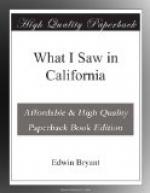“Government.—Upper California, on account of its small population, not being able to become a state of the great Mexican republic, takes the character of territory, the government of which is under the charge of a commandant-general, who exercises the charge of a superior political chief, whose attributes depend entirely upon the president of the republic and the general congress. But, to amplify the legislation of its centre, it has a deputation made up of seven vocals, the half of these individuals being removed every two years. The superior political chief presides at their sessions. The inhabitants of the territory are divided amongst the presidios, missions, and towns.
“Presidios.—The necessity of protecting the apostolic predication was the obligatory reason for forming the presidios, which were established according to circumstances. That of San Diego was the first; Santa Barbara, Monterey, and San Francisco were built afterwards. The form of all of them is nearly the same, and this is a square, containing about two hundred yards in each front, formed of a weak wall made of mud-bricks. Its height may be four yards in the interior of the square, and built on to the same wall. In its entire circumference are a chapel, storehouses, and houses for the commandant, officers, and troops, having at the entrance of the presidio quarters for a corps-de-garde.
“These buildings in the presidios, at the first idea, appear to have been sufficient, the only object having been for a defence against a surprise from the gentiles, or wild Indians in the immediate vicinity. But this cause having ceased, I believe they ought to be demolished, as they are daily threatening a complete ruin, and, from the very limited spaces of habitation, must be very incommodious to those who inhabit them. As to the exterior of the presidios, several private individuals have built some very decent houses, and, having evinced great emulation in this branch of business, I have no doubt but in a short time we shall see very considerable towns in California.
“At the distance of one, or at the most two miles from the presidio, and near to the anchoring-ground, is a fort, which has a few pieces of artillery of small calibre. The situation of most of them is very advantageous for the defence of the port, though the form of the walls, esplanades, and other imperfections which may be seen, make them very insignificant.
“The battalion of each presidio is made up of eighty or more horse soldiers, called cuera; besides these, it has a number of auxiliary troops and a detachment of artillery. The commandant of each presidio is the captain of its respective company, and besides the intervention, military and political, he has charge of all things relating to the marine department.
“Missions.—The missions contained in the territory are twenty-one. They were built at different epochs: that of San Diego, being the first, was built in 1769; its distance from the presidio of the same name is two leagues. The rest were built successively, according to circumstances and necessity. The last one was founded in the year 1822, under the name of San Francisco Dolores, and is the most northern of all.




